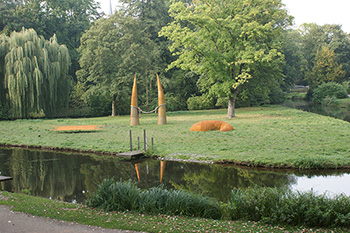The friends of Kulturinsel Nepix Kull have long since known that the place leads a double existence.
All year round it is a nature refuge where animals and plants largely exist all on their own; then, every year in September it also becomes a haven of culture, where the entire isle becomes a stage, a show case in the dual sense of the word, able to present the broadest range of shapes and phenomena that humans have create.
So, now it is a “fanfare against suffering”. Born in 1944 in Budapest, sculptor Gabrielle Fekete positioned this tripartite installation in the midst of the natural setting and it is hard to imagine a more idyllic setting.
At first sight, a massive ensemble that seems to grow out of the ground as if it had been here since the beginning of time. The isle, eluding the here-and-now, its links severed to the actual geographical space delimiting it, brings to mind an archaic settlement. Yet these impressions are ambivalent. They create an echo to the different in part contradictory levels of interpretations – oscillating between resilience on the one hand and exposure on the other.
The iron skin of the artefacts would no doubt be suitable as armour. But here any protective shield would be too late. The prey has already been killed, its fur skinned for later use, and only the stylized horns of the central figure still attest to former strength. Even the massive rope cannot be unequivocally placed. An observer may consider it a tool of enchainment and a symbol that there is no escape en route to the slaughterhouse; another may think that this is a rope that can give one a secure hold.
And the artist has added a third figure. It stands for the embryonic state of every sentient being. For the magic of the beginning and a, shall we say, paradise-like sense of innocence that harbours all potentiality. All the potential for future development. Including hope.
As a result, the eye of someone out for a walk and expecting to spy an idyllic vista will not be turned away by this fanfare, but all the more enduringly gripped by a captivating process of consideration and contemplation. This turmoil of feelings fuels the magic innate to these vast sculptures that Gabriella Fekete has given such archetypal primordial forms. It bears recollecting her “Zeittafel” here, with its faceless human heads at the end of parallel rail tracks. By eschewing any personal features she created, as it were, a matrix for all forms of suffering and not least also for sympathy and empathy.
Where an academic lecture with a meticulous list of the number of victims and the ghastly details from the torture chambers of this world would at best be some proverbial drum-banging against our minds, Fekete is far more subtle with her works, and perhaps precisely for this reason so emphatically affects our feelings.
This “Fanfare against suffering” needs no posters, let along angry cries of protest which, in a worst case, only triggers new violence. Gabriella Fekete battles suffering with symbols and figures, reduced to the basics, free of any fashionable cladding and also of the vocabulary of different cultural contexts – and therefore comprehensible the world over.
We should perhaps reveal one more thing: The sheer scale of this installation, here in Moerser Schlosspark, were a challenge even for the sculptor, versed though she is in monumental works.
A sculpture, or so she says, must make an impact from all sides. So it is appropriate that an isle is round. Yet the avian inhabitants are clearly at an advantage here over the two-legged visitors. They get a bird’s eye view of things.
Eva-Maria Zacharias |





